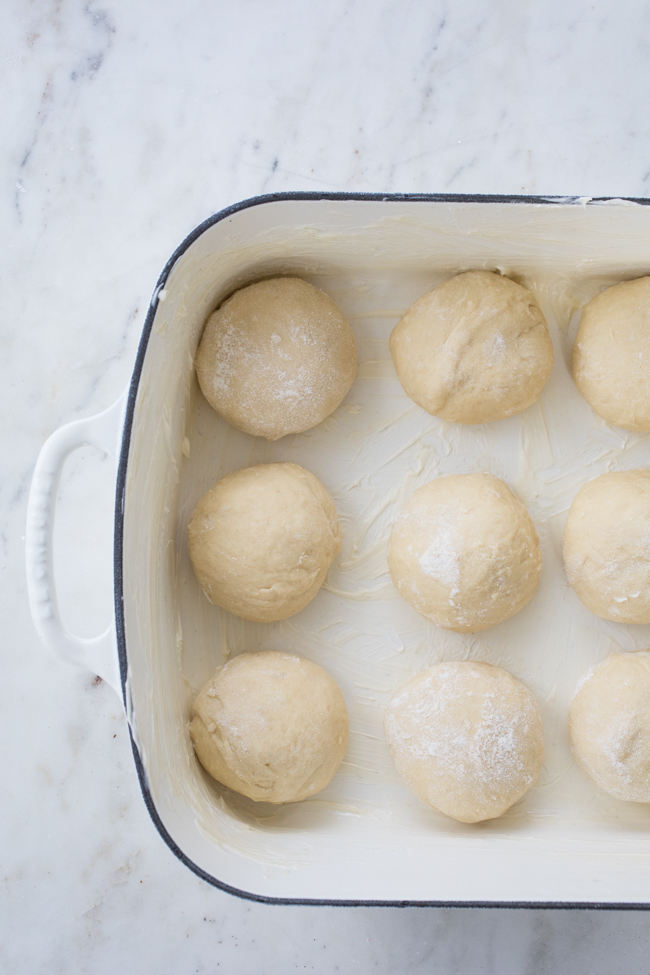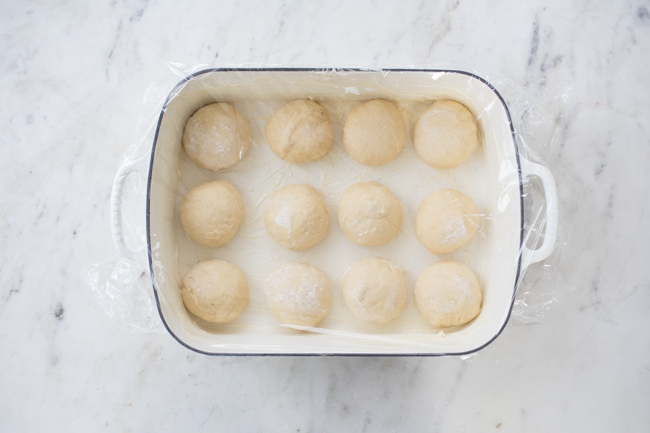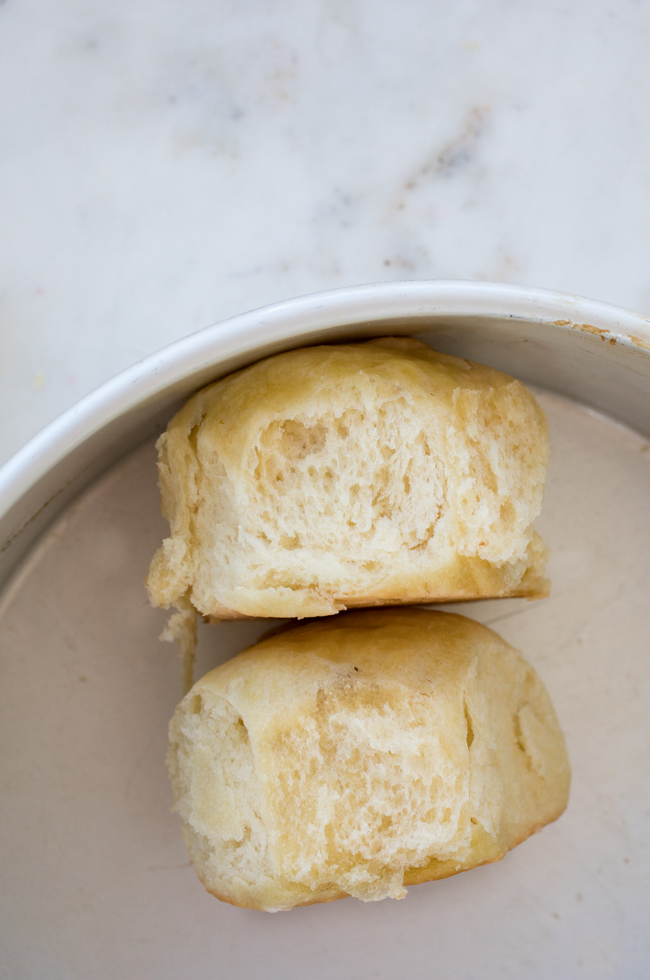Hawaiian Buns for Thanksgiving

Hawaiian Buns are a delicious treat: they are soft, and sweet, and perfect for both snacking on or serving with a warm meal. The most famous are, of course, the orange package of King’s Hawaiian buns found in your local supermarket. While the supermarket brand doesn’t contain pineapple or honey, those two ingredients were often used by Portuguese immigrants in Hawaii in the early 1900’s when refined sugar was scarce or too expensive to purchase. Our no-knead brioche and challah doughs already contained honey, so with just a little tweaking (and some pineapple juice and vanilla), we found ourselves with a great version of these famous buns, just in time for Thanksgiving dinner.
We have more Thanksgiving bun recipes on our site (Herb Crock Pot Dinner Rolls! Soft Pull Apart Buns!) and you can find links to them here. We also have a Thanksgiving round up post, complete with many of our sweet breads, plus a homemade-bread stuffing recipe, that you can check out here.
Hawaiian Buns
Fresh pineapple juice will not work here; the enzymes in fresh destroy the yeast. Some people heat the fresh juice with good results (this will kill the enzymes), but I’ve found canned to be the easiest (and cheapest) method. The pineapple juice can inhibit the yeast, so we use extra here to insure a good rise, and soft, tender buns. Having your eggs at room temperature will also help the dough rise quicker. The juice can also cause the melted butter to curdle when mixed, so I keep them separate until everything is mixed together. You can shape the buns the night before serving and let them do a slow rise overnight in the refrigerator.
1 cup [240 g] lukewarm water (100F or below)
1/2 cup [120 g] canned pineapple juice (fresh will not work here, see note above), room temperature
2 tablespoons yeast
1/4 cup [50 g] granulated sugar
1 cup [2 sticks | 226 g] unsalted butter, melted
1/2 cup [170 g] honey
1 tablespoon pure vanilla extract
5 eggs, room temperature, lightly beaten
1 tablespoon kosher salt
7 cups [990 g] all-purpose flour
In a liquid measuring cup, mix together the water, canned pineapple juice, yeast, and sugar.
Mix the butter, honey, eggs, vanilla, and salt together in a 6-quart bowl or lidded (not airtight) food container.
Pour in the flour and begin to mix, slowly adding the water/pineapple mixture. Use a Danish dough whisk to combine all the ingredients together (this can also be done in a heavy-duty stand mixer fitted with a paddle). The dough will be loose but will firm up when chilled; don’t try to work with it before chilling.
Cover (not airtight), allow to rest at room temperature for 2 hours, and then refrigerate.
The dough can be used as soon as it’s thoroughly chilled, at least 3 hours. Refrigerate the container and use over the next 3 days.

On baking day, cut off 1-pound (grapefruit-size) piece of dough and divide the dough into 8 pieces. Quickly shape the pieces into balls. Place the balls in a greased 8 x 8-inch baking dish, or an 8-inch cake pan. If you want more than 8 buns, as shown in the photos, double the quantity of dough used, or pull cut 2.5 ounce pieces to make the amount needed. If you want pull-apart buns, nestle the buns close together. Cover and allow to rest for 1 hour. Brush the tops with egg white (this will give them some shine).

Bake the buns at 350F for 16 minutes. Brush the tops of the buns with melted butter, then bake for 5 to 8 more minutes, until the tops are golden brown. Remove the pan from the oven, and brush the tops with more melted butter.

Serve slightly warm and enjoy! These buns can also be made in a Crock pot, follow our direction for Crock Pot Buns here.


Note: BreadIn5.com is reader supported–when you buy through links on the site, BreadIn5 LLC earns commissions.
Looks good but I have a question about the butter. It says 1 Cup (3sticks) of butter. There are 8 Tablespoons to a stick of butter. 16 Tablespoons makes a Cup, which would be 2 sticks. Is it 2 sticks or 3 for these rolls?
Hi Melissa,
It was a typo, but we’ve fixed it.
Enjoy! Zoë
How many 1# batches does this recipe make?
Hi Michael,
It makes about 4 pounds of dough.
Thanks, Zoë
do you know if we could substitute pineapple juice for anything? its not the kind of thing I always keep in my refridgerator.
Hi Hillary,
You can use orange juice or just water, but the flavor will be slightly different.
Thanks, Zoë
When following your directions…..do you suggest weight? You say “7 cups all purpose flour 990 g”
My King Arthur all purpose flour at 7 cups will measure 840 g.
Thanks!
Hi Cheryl,
We always suggest going with weights. The number of cups will depend on how you fill the measuring cups. KAF uses the “spoon and sweep” method and we use the “scoop and sweep”, so our cups are heavier.
Thanks, Zoë
Perfect…..thanks Zoe!
can I substitute orange juice for pineapple? and, will I have to heat it?
That should work, yes. And no need to heat it
I purchased your book several years ago; every time I use it galls me because I “bought” a book which I expected to list ingredients by weight and received one which was, obviously, an “earlier edition!” Have you written a conversion table for weight vs. “volume” as used in your “newer” book?
Hi T.J.,
It took us years to convince our publisher that weights were an essential part of baking, but it just wasn’t “the norm” at the time, so they didn’t feel people would “respond well.” Times have changed and now lots, but not all, books are written with weights. I am always pleasantly surprized when I see weights in a book, but still enjoy books that don’t. We have taken the time to add weights to the recipes on this blog, but there is not a specific conversion chart.
Thanks and enjoy the bread! Zoë
Zoe,
Can I shape the rolls and refrigerate overnight for the second rise?
Thanks
Ricki
Hi Ricki,
Yes, you sure can, I do it all the time.
Thanks, Zoë
Zoe,
I’ve made these before and they are wonderful. Do you think they will require adjustments for altitudes at around 6,000 feet?
Ricki
Hi Ricki, My best guess is that you don’t need any adjustments. I’ve baked in Denver which is just a little less altitude than where you’re at, and no adjustments were needed with any of the wheat based breads.
Hi! Your book, “New Artisan Bread in Five Minutes a Day” has been so helpful to me over the years. Originally, I made homemade bread for economic reasons, as I was a new stay-at-home mom trying to keep costs down at home.
After my youngest was born, we found out he had many food allergies, making finding safe store-bought food challenging. Since the start of 2023, when the FASTER act was implemented in the US making sesame a top allergen, families with sesame allergies such as ours, are finding it challenging finding safe breads for our families. Many bread producers are now adding sesame flour to their products, greatly restricting our safe bread options. Your book and recipes have become so helpful in my house yet again!
Recently, I’ve begun a YouTube channel to try and help allergy families such as mine find products and recipes for their families. I’m new at it, but I’ve learned so much. Two products which are super hard to find right now for sesame allergic families are vegan (dairy and egg free for allergies’ sake) Hawaiian rolls and hot dogs buns. I would love to feature your book in an upcoming video on how I’ve begun making bread at home again and was wondering if you have any tips on how to make this Hawaiian roll recipe egg free? Even though my family doesn’t currently need an egg free recipe, as my kiddo recently out grew his egg allergy, I know MANY families are egg, milk, and sesame allergic. I would of course give all credit to you both. I was thinking of modifying your buttermilk bread with a milk substitute such as soy and swapping some of the water for pineapple juice as you listed here. This recipe is much more rich, however, with the butter and honey as well. Any tips you have would be welcome. Thanks for all your wonderful recipes that make baking bread much more approachable!
Wow, Hawaiian rolls really need the eggs, but an enriched dough of any kind, especially if you top the rolls with butter or oil before you bake– might be about right.